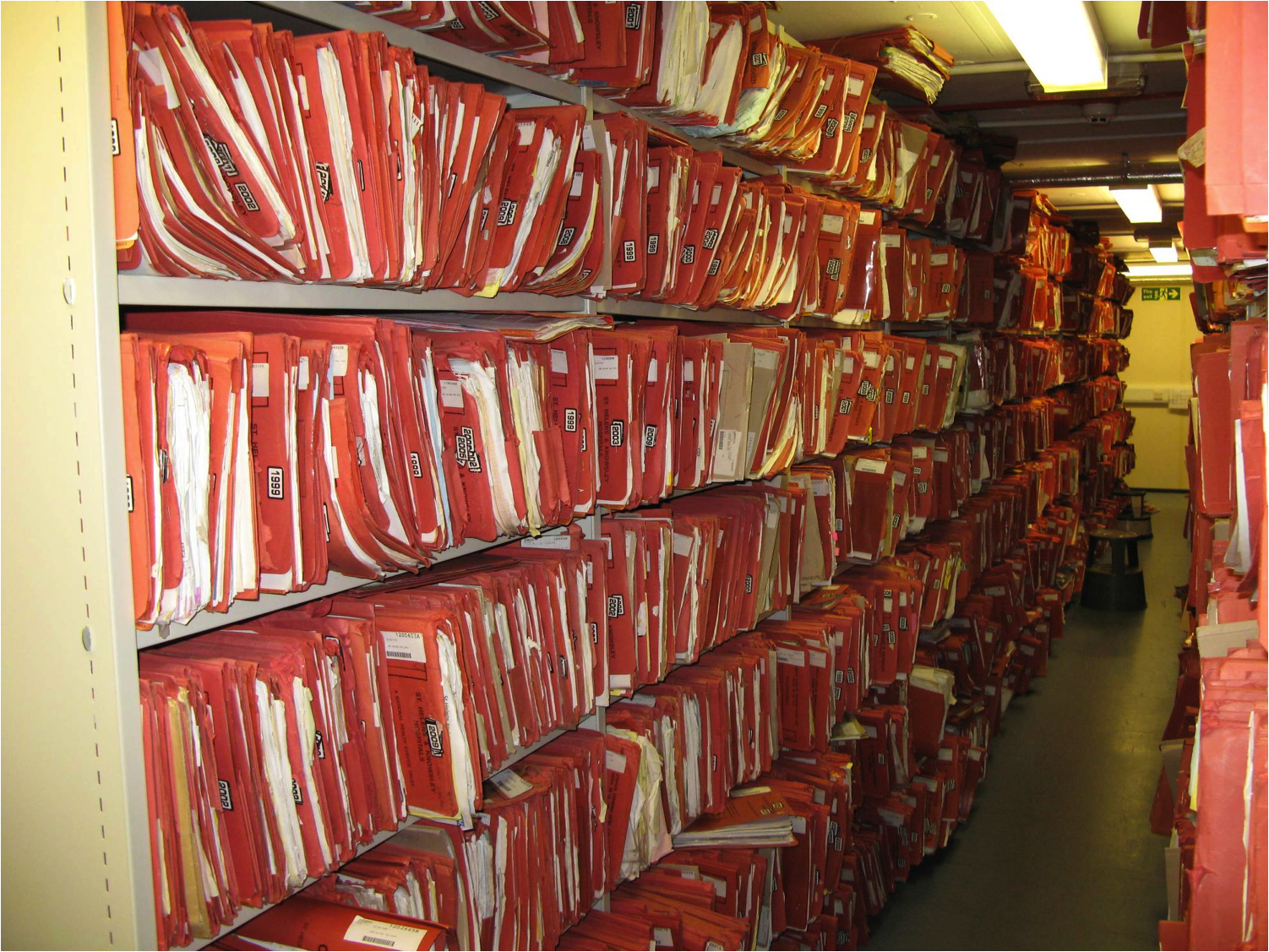Record breakers
Widely considered the best sprinter of all time with gold medals in 100 and 200 metres from three consecutive Olympic Games, the Jamaican athletics icon Usain St Leo Bolt is a speed phenomenon. Now retired, he still holds the 100 metres record at 9.58 seconds set in 2009 at the Berlin World Athletics Championships. Bolt achieved an average speed of 23.35 mph although data shows he hit a mind boggling 27.8 mph mid-race; no wonder then he’s affectionately nicknamed Lightning Bolt.
Another record breaker from 2009 - and in this case it's actually physical records - is St Helens and Knowsley Teaching Hospitals NHS Trust. It was the first trust in the UK to stop using paper medical records in clinical practice after migrating to an electronic document and records management system (EDRMS) to coincide with the opening of two hospitals costing £338 million at Whiston and St Helens.
The EDRMS meant the Trust stopped hand delivering 7,000 paper files to outpatient departments each week and then filing them in reverse. Its records library subsequently closed; a building containing over a million folders, each holding on average 250 pages. The EDRMS software and scan-on-demand approach cost £1.2 million with annual savings of £1.4 million realised as storage and transportation costs were cut and staff redeployed.

Jamaican athletics icon Usain St Leo Bolt
The upshot? By going digital, the new IT system paid for itself within a year and a vast amount of money has been saved ever since. The Trust could guarantee the right medical records for the right patient were available to the right doctor at the right time. This has reduced elective care appointment cancellations because notes were lacking, improved clinical productivity as more patients are seen, enhanced patient safety and overall clinical care.
Which is a useful segue to the focus of this article: the Government’s recent Budget Statement where Rishi Sunak announced an extra £2.1 billion - as part of a £5.9 billion total - to improve technology and data in the NHS; so-called digital transformation.
Clearly this is a broad area. To just focus on patient records for a moment, too many Trusts are still far to paper-based. According to our own Freedom of Information requests, this is significant with 50% of the 233 Trusts in the country yet to transition to computer-based systems like St Helens and Knowsley did 13 years ago.
It begs the question why so many have been slow to embrace change and what should be done with the new funds to ensure best return on investment.
Why has it taken so long to get rid of the paper and why digitise now?
The Coronavirus pandemic has revealed that the NHS has simply not put enough effort and investment into digitisation despite Health Secretaries – specifically Jeremy Hunt – challenging the NHS to be paperless. He wanted this by 2018 although his predecessor Andrew Lansley pledged to start an information revolution back in 2010.
There are various reasons why. First, whilst funding was available at an umbrella level, it didn’t universally filter down to support local digitisation projects. Second, other IT priorities have consumed budget. Third, a lack of people resources and ownership to drive projects through has hindered progress with records digitisation delayed time and again. Fourth, some Trusts have managed the process poorly by not indexing or classifying information properly which has meant the digital solution offered is actually worse than delivering paper. They’ve presented time-pressed clinicians a large PDF displaying pages of historical notes which is impossible to navigate when consultations last just 15 minutes. End-user system acceptance and adoption therefore failed.
In the post Covid world, clinicians and their patients are often geographically separate. Nor are paper notes helpful when multi-disciplinary medical teams come together in an individual’s treatment and need access to the same information. Paper notes self-evidently aren’t practicable and compromise patient safety hence the impetus to revisit digitisation.
Furthermore, an average paper record is literally handled 10 to 15 times from storage to delivery. Not only is there an infection risk as people touch the paper but the costs just keep mounting each time files are requested and then put away.
The time is therefore right to address this: an invest to save process to get rid of the paper once and for all which will boost efficiency in the future.

How should the new money allocated for NHS IT be spent?
New money for NHS IT is welcome, but we should be cognisant of the errors made in the past. The National Programme of IT championed by the Blair Government in 2002 is the poster child of how not to manage things. It failed as IT systems were foisted upon Trusts – a ‘top down’ approach which didn’t take into account local needs. It cost the taxpayer billions and was dismantled in 2011.
A number of key imperatives should be considered to ensure the new cash is well spent – a top 10 of focus areas listed below:
1. Digital transformation is a loose term which requires clearer definition about what it actually involves given it means many things to different people. The scope must be made more specific namely: which areas of technology, the costs and the expected benefits;
2. Spending should be allocated to tackle obvious problem areas first to provide quick wins. Patient records is one obvious example.
3. Innovation should be championed and promoted with Trusts free to make their own decisions about the IT systems they want based on local requirements.
4. Systems deployed must abide to uniform data standards enforced by the Department of Health and Social Care (DHSC). This means System A from Supplier 1 can talk to System B from supplier 2 and so on. HL7-FHIR is just one example for exchanging healthcare information electronically, along with SNOMED CT which contains all the clinical terms required to document procedures, symptoms, clinical measurements, diagnoses, medications and so on. It gives IT systems a shared language that everyone can use.
5. IT interoperability, therefore, must be at the heart of any future national NHS IT investment – and to repeat the point again - enforced fastidiously by the DHSC with suppliers penalised if they act in commercial self-interest. There is too much of this going on already, with the NHS likely to be held to ransom in the long term with costly fees and propriety ‘lock in’.
Incumbent clinical IT vendors must be managed closely so they do not act in monopolistic ways preventing other suppliers who could offer additional functionality that adds value to be integrated easily.
APIs are a very good example of this. All suppliers say in their NHS bidding questionnaires that they have open APIs. The reality is that some then make it difficult for other firms to use them or want to charge for access – in effect double charging the NHS. Once Trusts have purchased software licenses, APIs need to be free so integration is simplified and ‘air gaps’ between systems are avoided.
6. Government must not be seduced by big or trendy technology firms who appear to offer ‘the’ perfect solution. It doesn’t exist. Competition is key and must be encouraged. And competition comes from all sizes of firms.
7. The convoluted and complex NHS procurement process which negatively effects SMEs needs to be simplified. Once a firm is authorised on an appropriate framework, they should be free to bid on technical merit rather than wasting time on onerous form filling which impacts smaller firms disproportionately harder than larger companies.
8. Care should be taken to ensure the ‘right’ technology is used for specific purposes rather than systems ‘stretched’ to do things outside their main scope. For example, clinical EPR systems used in both primary and secondary are perfect for holding structured clinical data. They’re not designed to hold large volumes of unstructured information from scanned legacy patient records which requires lifecycle management rules to be applied to the data contained.
9. The application of any technology should address specific problems and whatever solution is installed must be expandable over time so that ‘roadblocks’ in the future are avoided. Trusts that fail to do this to a reasonable level of detail are likely to suffer from difficulties over time.
10. IT departments must engage and work closely with their end-user community about system selection given it is clinical practitioners who use the technology day to day. It cannot be an ‘us’ doing it to ‘them’ approach.
The numbers associated with UK healthcare provision are staggering given the Coronavirus pandemic, an ageing population and the growing number of people who need medical treatment every day. To put some shape to this, the ONS estimates that the UK Government spent in the region of £220 billion on healthcare in 2020.
It is essential that we maximise the use of our finite financial resources and the extra budget announced by Sunak in October 2021. If the NHS focuses on the areas above, then like Bolt himself, digital transformation has every opportunity to be a running success.
For further information, click the link below or email info@ccubesolutions.com
